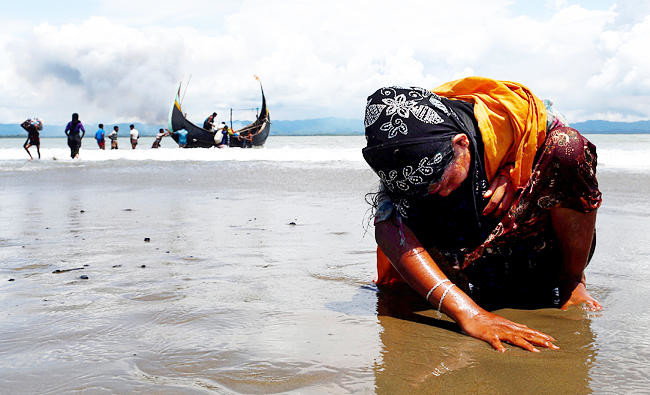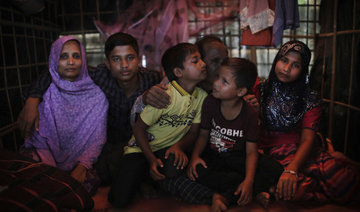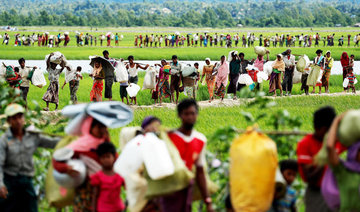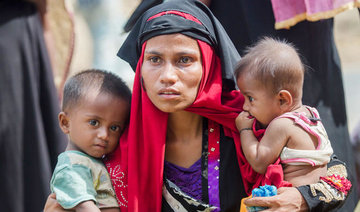BANGKOK: After facing international outrage and charges of ethnic cleansing, Myanmar made a pledge: Rohingya Muslims who fled the country by the hundreds of thousands would start their journey home within weeks.
With so many obstacles, however, and no real sign of good will, few believe that will happen.
The returns are supposed to be voluntary. But many members of the religious minority, now living in sprawling refugee camps in neighboring Bangladesh, are afraid to go back.
They don’t trust the nationalist-led government and feel widely hated by the general population. Meanwhile, the military — which violently ousted them — says the refugees shouldn’t expect to return in large numbers.
Myanmar, a predominantly Buddhist nation of 60 million, was basking in international praise just a few years ago as it transitioned to democracy after a half-century of dictatorship. Since then, a campaign of killings, rape and arson attacks by security forces and Buddhist-aligned mobs have sent more than 850,000 of the country’s 1.3 million Rohingya fleeing.
Their home for generations, the northern tip of Rakhine state, is now virtually empty, prompting the United Nations, the United States and others to label it ethnic cleansing.
In an apparent effort to quiet criticism, Myanmar reached an agreement with Bangladesh last month saying refugees would start returning home before Jan. 23.
There is “no way” that will happen, says Chris Lewa, a leading expert on the Rohingya and the policies that have made them one of the world’s most persecuted minorities. The government, she notes, has done almost nothing to prepare.
While Myanmar said the Rohingya would be allowed to settle in their original homes, few of which remain standing, some officials have talked about putting them in “camps” in northern Rakhine.
Already, two barracks have been constructed next to a police post in the Rakhine state village of Taungpyo Letwe to receive returnees, the Ministry of Information says. The government has stockpiled material and started breaking ground for 41 modular houses.
The idea, the ministry said, is that returnees can stay there temporarily.
That scares Arif Ullah, a 34-year-old Rohingya living at the Balukali camp in Bangladesh. He worries it could lead to something more permanent like apartheid-style camps erected after violence broke out in Sittwe, the state capital, in 2012.
Five years later, those camps remain home to 120,000 people. International aid agencies are effectively banned and the Rohingya have little access to food, education or basic medical care. Mothers regularly die in childbirth. Babies and children have clear signs of malnutrition.
“We miss our home,” said Arif Ullah, married and a father of two. “But we are human beings.”
“If the Myanmar government is really willing to take us back and give us our rights, they could have built houses on the land where our houses were burned down,” he says. “But clearly they don’t want to do that. And we are not going back to just live in the camps.”
Anagha Neelakantan, Asia Director of the International Crisis Group, meanwhile, warned of potential security risks. She also does not believe large numbers of Rohingya will be returning from Bangladesh any time soon.
And the presence of so many traumatized, hopeless refugees in Bangladesh, she said, could be a recipe for further instability and possible cross-border attacks by Rohingya militants, known as ARSA.
Attacks by ARSA inside Rakhine state — first in October 2016 and then again in August — triggered the army’s heavy-handed, indiscriminate response.
Well-trained and funded in part by the Middle East, the militants’ agenda appears to be to localized. They want the Rohingya to enjoy the same rights as others in Myanmar. But if the situation does not improve, there are fears the militants could be exploited by transnational jihadists with their own aims.
Min Aung Hlaing, commander-in-chief of the armed forces, says the decision as to who returns and when should not be left to governments. It should be for residents inside Myanmar to decide.
“It is impossible to accept the number of persons proposed by Bangladesh,” he said last month in a statement. “Emphasis must be placed on wish of local Rakhine ethnic people who are real Myanmar citizens. Only when local Rakhine ethnic people accept it, will all the people satisfy it.”
Though many Rohingya have been living in Myanmar for generations, they are seen by most people in the country as “foreign invaders” from Bangladesh. They have been denied citizenship, effectively rendering them stateless.
In addition to saying the Muslim minority should be allowed to return freely, safely and in dignity, Myanmar’s agreement with Bangladesh says Rohingya will need to provide evidence of their residency — something many say they do not have.
While the agreement says that the UN High Commission for Refugees will play a role in the repatriations, Adrian Edwards, a spokesman in Geneva, said they have so far been excluded from initial discussions between Myanmar and Bangladesh.
Bangladesh wants them to be involved, sources say. Myanmar does not.
“After the widespread atrocities, safe and voluntary return of Rohingya will require international monitors on the ground in Burma (Myanmar),” says Bill Frelick, refugee rights director at Human Rights Watch. This, he says, means a central role for the UNHCR.
But how that can happen and when is just one of the many obstacles to a Rohingya return to Myanmar that many fear, many simply don’t want — and that, in the context of the months of violence that 2017 brought to so many people, is for the moment a political talking point and very little else.
No sign Rohingya will be allowed to return home
No sign Rohingya will be allowed to return home

Australian trust in US fell, but security alliance vital, says poll

Cyberattacks from other nations were seen as the top threat (70 percent), while concern over potential conflicts over Taiwan (59 percent) and the South China Sea (57 percent) also loomed large.
Australia has boosted its military cooperation with alliance partner the United States, including in the AUKUS nuclear submarine deal, as government concern over the risk of conflict in the Indo-Pacific region rises.
The Lowy Institute poll, conducted annually by the foreign policy think-tank for 20 years, found Australians rank Japan highest of all countries in terms of trust (87 percent).
Trust in China to act responsibly in the world was low at 17 percent, which Lowy said was a sharp drop from 52 percent six years ago.
Levels of trust toward the United States dropped five points to 56 percent from a year ago.
“Australians are far less trusting of China and they are worried about the risk of war in our region. One constant is that they continue to see the alliance with the United States as important to Australia’s security,” said Lowy Institute executive director Michael Fullilove.
Most (83 percent) of 2000 people surveyed in March said the US alliance was important for Australia’s security.
Sixty-three percent said the US alliance makes Australia safer from attack or pressure from China, although three-quarters also believe the alliance makes it more likely Australia will be drawn into a future war in Asia.
Seventy-one percent said China would become a military threat to Australia in the next 20 years.
Asked about the 2024 US presidential election, 68 percent said they would prefer to see Joe Biden re-elected, compared with a third (29 percent) preferring Donald Trump.
Scholz to Putin: We will defend ‘every square inch’ of NATO territory

- Russian President Vladimir Putin earlier this week warned NATO members against allowing Ukraine to fire their weapons into Russia
FRANKFURT: NATO’s recent move to strengthen its eastern border is aimed at deterring Russia, German Chancellor Olaf Scholz said on Sunday, adding it should be clear to Moscow that the alliance will be ready to defend itself if necessary.
Speaking at the Eastern German Economic Forum also attended by Lithuanian Prime Minister Ingrida Simonyte, Scholz said Germany has played a leading role in NATO’s presence in the Baltics on Russia’s border, stretching back nearly a decade.
“And because the threat from Russia will continue, we and other allies decided last year to deploy additional units to the Baltic states and to station an entire brigade there permanently in future,” Scholz said, according to a speech manuscript.
“But this turnaround in security policy is necessary to show Russia: We are prepared to defend every square inch of NATO territory against attacks.”
He said diplomacy would only be successful from a position of strength.
Russian President Vladimir Putin earlier this week warned NATO members against allowing Ukraine to fire their weapons into Russia, after several Western allies lifted restrictions imposed on the use of weapons donated to Kyiv.
NATO chief Jens Stoltenberg on Friday dismissed the warnings, saying the alliance had heard them many times before and self-defense was not escalation.
US, South Korea and Japan agree to hold joint military exercises

SEOUL/TOKYO: The United States, Japan and South Korea agreed to hold new trilateral joint exercises this summer, a joint statement issued by USDepartment of Defense said on Sunday, after a meeting of the three allies’ defense ministers.
US Defense Secretary Lloyd Austin, Japan’s Defense Minister Minoru Kihara and South Korea’s Defense Minister Shin Won-sik met on Sunday in Singapore on the sidelines of the annual Shangri-La Dialogue security summit there.
The three “committed to continue to strengthen trilateral cooperation to ensure peace and stability in the Korean Peninsula, the Indo-Pacific, and beyond,” according to the statement.
The three also agreed to establish a Trilateral Security Cooperation Framework this year in an effort to institutionalize their three-way defense cooperation.
The top defense officials of the three countries criticized North Korea’s recent launches of ballistic missiles and a military spy satellite using ballistic missile technology as a violation of United Nations Security Council resolutions.
Trump’s appeal of hush money verdict to focus on Stormy Daniels testimony

NEW YORK: Former President Donald Trump vows to appeal his historic conviction, with the focus likely on porn star Stormy Daniels’ salacious testimony about their alleged sexual encounter as well as the novel legal theory that prosecutors used in the case.
“We’re going to be appealing this scam,” Trump, the 2024 Republican candidate for president, said on Friday. He faces an uphill fight.
His defense lawyer Todd Blanche told CNN on Thursday that Trump would appeal after his July 11 sentencing date, meaning it is unlikely to be resolved before his Nov. 5 election rematch with Democratic President Joe Biden.
Twelve jurors found the real estate mogul-turned-politician guilty on Thursday of falsifying business records to cover up his former lawyer Michael Cohen’s $130,000 hush money payment to Daniels to illegally influence the 2016 election which he won.
Trump pleaded not guilty and denies having had sex with Daniels, whose given name is Stephanie Clifford. He argues the Manhattan District Attorney’s office, led by Democrat Alvin Bragg, brought the charges to derail his presidential campaign.
To succeed on appeal, Trump, 77, must demonstrate that Justice Juan Merchan made significant errors overseeing the trial.
If Trump’s appeal in New York state courts proves unsuccessful, he could appeal to the US Supreme Court. Trump’s attorneys would have to persuade at least four of the court’s nine justices to hear his case.
To prevail, Trump would then have to demonstrate that the state prosecution violated his federal constitutional rights and that his legal team followed proper procedures during earlier stages of his legal proceedings.
Trump would not be able to bypass lower state courts to immediately appeal to the Supreme Court, but he might try to seek relief if, for example, he was subject to imprisonment in the middle of his election campaign.
The court’s 6-3 conservative majority includes three Trump appointees, and it has handled other Trump-related cases in ways that have proven helpful to his candidacy.
When the court agreed in late February to take up Trump’s claim that he has absolute immunity from prosecution for actions taken as president, they put off hearing the case until late April. That delay may prevent Trump’s Washington trial on federal election subversion charges, to which he has pleaded not guilty, from taking place before the election.
IS A MAGAZINE SPANKING RELEVANT?
On appeal, Trump’s lawyers will likely argue that Daniels’ testimony about a Lake Tahoe hotel encounter went into too much detail for a case that hinged on whether Trump falsified documents rather than on whether he had sex with Daniels.
On May 7, Daniels testified that she hit Trump’s backside with a rolled-up magazine and that he did not use a condom. She mentioned the position she said they were in. She said she “blacked out” and did not remember how her clothes came off, though she said she did not consume alcohol or drugs and never said “no” to Trump during the encounter.
Defense lawyer Todd Blanche twice asked Merchan to declare a mistrial based on her testimony, which he said prejudiced the 12-member jury.
“How can we come back from this in a way that’s fair to President Trump?” Blanche said outside the jury’s presence on May 7.
The judge denied both requests, in part because Blanche said in his April 22 opening statement that Daniels’ account of an encounter with Trump was false. Merchan said that entitled prosecutors to elicit testimony to establish her credibility.
Rebecca Roiphe, a professor at New York Law School, said none of Merchan’s decisions stood out as obvious mistakes, lessening Trump’s lawyers’ chances of getting the conviction overturned.
“I can’t imagine an appeals court would say the newspaper spanking warrants a reversal,” said Roiphe, a former prosecutor with the Manhattan District Attorney’s office.
NOVEL THEORY
Besides Daniels’ testimony, the defense could argue on appeal that the judge’s gag order restricting Trump’s public statements about witnesses violated his rights. Trump alluded to that on Friday, complaining about restrictions the judge imposed on potential testimony from an election law expert whom the defense ultimately opted not to call as a witness.
“We’re going to be appealing it on many different things. He wouldn’t allow us to have witnesses. He wouldn’t allow us to talk, he wouldn’t allow us to do anything,” Trump said.
The defense is also likely to argue the charges were themselves legally improper. Some legal experts have said that the case could be vulnerable to such a challenge because the prosecution’s legal theory has not been tested on appeal.
Falsifying business records on its own is a misdemeanor in New York, but it is elevated to a felony if done to further or conceal another crime.
In this case, prosecutors said Trump was seeking to cover up a conspiracy he and Cohen were involved in to promote a candidacy for public office through unlawful means, a misdemeanor in New York state. They say the hush money payment to Daniels was effectively a campaign contribution that exceeded the $2,700 limit on political donations in 2016.
In urging Merchan to dismiss the case last year, Trump’s lawyers argued that New York state law did not apply to federal elections.
Merchan allowed the case to go forward, but Boston University law professor Jed Shugerman said the law was ambiguous on that point, potentially posing an issue on appeal.
George Grasso, a retired New York state judge who attended the trial, said the defense would be unlikely to succeed in a challenge to that decision.
“They’ll try to appeal everything,” Grasso said but added he thought the judge’s decision was sound.
China lands on moon’s far side in historic sample-retrieval mission

- Chang’e-6 craft touched down in gigantic crater on moon’s space-facing side
- The landing elevates China’s space power status in a global rush to the moon
BEIJING: China landed an uncrewed spacecraft on the far side of the moon on Sunday, overcoming a key hurdle in its landmark mission to retrieve the world’s first rock and soil samples from the dark lunar hemisphere.
The landing elevates China’s space power status in a global rush to the moon, where countries including the United States are hoping to exploit lunar minerals to sustain long-term astronaut missions and moon bases within the next decade.
The Chang’e-6 craft, equipped with an array of tools and its own launcher, touched down in a gigantic impact crater called the South Pole-Aitken Basin on the moon’s space-facing side at 6:23 a.m. Beijing time (2223 GMT), the China National Space Administration said.
The mission “involves many engineering innovations, high risks and great difficulty,” the agency said in a statement on its website. “The payloads carried by the Chang’e-6 lander will work as planned and carry out scientific exploration missions.”
The successful mission is China’s second on the far side of the moon, a region no other country has reached. The side of the moon perpetually facing away from the Earth is dotted with deep and dark craters, making communications and robotic landing operations more challenging.
Given these challenges, lunar and space experts involved in the Chang’e-6 mission described the landing phase as a moment where the chance of failure is the highest.
“Landing on the far side of the moon is very difficult because you don’t have line-of-sight communications, you’re relying on a lot of links in the chain to control what is going on, or you have to automate what is going on,” said Neil Melville-Kenney, a technical officer at the European Space Agency working with China on one of the Chang’e-6 payloads.
“Automation is very difficult especially at high latitudes because you have long shadows which can be very confusing for landers,” Melville added.
The Chang’e-6 probe launched on May 3 on China’s Long March 5 rocket from the Wenchang Satellite Launch Center on the southern island of Hainan, reaching the lunar vicinity roughly a week later before tightening its orbit in preparation for a landing.
Chang’e-6 marks the world’s third lunar landing this year: Japan’s SLIM lander touched down in January, followed the next month by a lander from US startup Intuitive Machines.
The other countries that have sent spacecraft to Earth’s nearest neighbor are the then-Soviet Union and India. The United States is the only country to have landed humans on the moon, starting in 1969.
SAMPLING THE MOON
Using a scoop and drill, the Chang’e-6 lander will aim to collect 2 kg (4.4 pounds) of lunar material over two days and bring it back to Earth.
The samples will be transferred to a rocket booster atop the lander, which will launch back into space, tag up with another spacecraft in lunar orbit and return, with a landing in China’s Inner Mongolia region expected around June 25.
If all goes as planned, the mission will provide China with a pristine record of the moon’s 4.5 billion-year history and yield new clues on the solar system’s formation. It will also allow for an unprecedented comparison between the dark, unexplored region with the moon’s better understood Earth-facing side.
A simulation lab for the Chang’e-6 probe will develop and verify sampling strategies and equipment control procedures, China’s official Xinhua news agency said. It will use a full-scale replica of the sampling area based on exploration results on the environment, rock distribution and lunar soil conditions around the landing site.
China’s lunar strategy includes its first astronaut landing around 2030 in a program that counts Russia as a partner. In 2020 China conducted its first lunar sample return mission with Chang’e-5, retrieving samples from the moon’s nearer side.
The US Artemis program envisions a crewed moon landing by late 2026 or later. NASA has partnered with space agencies including those of Canada, Europe and Japan, whose astronauts will join US crews on an Artemis mission.
Artemis relies heavily on private companies, including Elon Musk’s SpaceX, whose Starship rocket aims this decade to attempt the first astronaut landing since NASA’s final Apollo mission in 1972.
On Saturday Japanese billionaire Yusaku Maezawa canceled a private mission around the moon he had paid for, which was to have used SpaceX’s Starship, citing schedule uncertainties in the rocket’s development.
Boeing and NASA postponed the company’s first crewed launch of Starliner, a long-delayed capsule meant to become the second US space taxi to low-Earth orbit.














